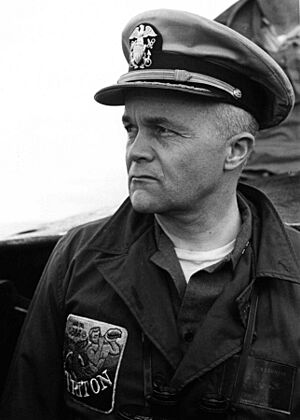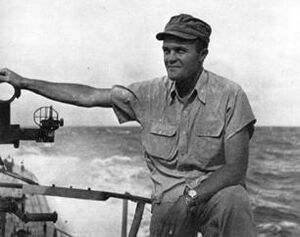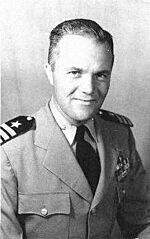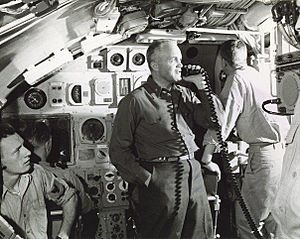Edward L. Beach Jr. facts for kids
Quick facts for kids
Edward Latimer Beach Jr.
|
|
|---|---|

Edward L. Beach Jr. in 1960
|
|
| Nickname(s) | Ned |
| Born | April 20, 1918 New York City, U.S. |
| Died | December 1, 2002 (aged 84) Washington, D.C., U.S. |
| Buried |
United States Naval Academy Cemetery
|
| Allegiance | United States of America |
| Service/ |
|
| Years of service | 1939–1966 |
| Rank | Captain |
| Commands held | USS Piper (SS-409) USS Amberjack (SS-522) USS Trigger (SS-564) USS Williamsburg (AGC-369) USS Salamonie (AO-26) USS Triton (SSRN-586) Submarine Squadron 8 |
| Battles/wars | Neutrality Patrol World War II Battle of Midway Cold War |
| Awards |
|
| Other work | Author, historian |
Edward Latimer Beach Jr. (born April 20, 1918 – died December 1, 2002) was a brave United States Navy submarine officer. He was also a famous author.
During World War II, he fought in the important Battle of Midway. He went on 12 combat patrols, showing great courage. For his actions, he received 10 awards, including the Navy Cross. After the war, he worked for President Dwight D. Eisenhower. He also commanded the first submarine to travel around the world underwater.
Beach wrote a very popular book called Run Silent, Run Deep. This book was later made into a movie in 1958. Edward L. Beach Jr. was born in New York City. He grew up in Palo Alto, California. His father, Edward L. Beach Sr., was also a Navy captain.
Contents
Edward Beach joined the United States Naval Academy in 1935. He was a very good student and graduated second in his class in 1939. He was known for boosting morale and loyalty among his fellow students.
His first assignment was on the ship USS Chester. Then, he joined the destroyer USS Lea. This ship helped patrol the Atlantic Ocean. It also helped protect ships and was part of the first American occupation of Iceland.
In September 1941, Beach started special training to become a submarine officer. He finished his training in December 1941, right after the attack on Pearl Harbor. He graduated first in his class.
World War II Service
During World War II, Beach served on two submarines: USS Trigger and USS Tirante. He later took command of USS Piper as the war was ending.
On the USS Trigger, Beach held many jobs. He was the communications officer, engineer, and executive officer. He went on 10 war patrols with Trigger. He also took part in the Battle of Midway. The USS Trigger earned special awards for its bravery during this time.
Later, Beach joined the new USS Tirante as the executive officer. During one patrol, the Tirante made a very brave attack in a Japanese harbor. For his heroism during this patrol, Beach received the Navy Cross. The Tirante also received a special unit award.
Beach became the commander of USS Piper in June 1945. The war ended soon after, and Piper was in Japanese waters when the surrender was signed.
Overall, during World War II, Beach earned 10 awards for his bravery. He went on 12 war patrols. His submarines damaged or sank 45 enemy ships.
Cold War Missions
After World War II, Beach worked for the United States Department of the Navy. He served as a personal assistant to a high-ranking admiral. He also worked on atomic defense plans.
Commanding USS Amberjack
In 1948, Beach became the commander of USS Amberjack. This submarine was known for its daring dives and climbs. It even got the nickname "Anglejack." During war games, Amberjack once secretly photographed an enemy admiral's ship. Then, they sent the admiral a copy of the photo!
Working with the Joint Chiefs
From 1949 to 1951, Beach worked in Washington, D.C. He was a naval aide to General Omar Bradley. Bradley was the first leader of the Joint Chiefs of Staff. This group advises the President on military matters.
Leading USS Trigger II
In 1951, Beach took command of a new submarine, Trigger (SS-564). This submarine was named after the first USS Trigger, which was lost during the war. It was one of the first new submarines built after World War II.
Serving at the White House
From 1953 to 1957, Beach was a naval aide to President Dwight D. Eisenhower. He helped manage Camp David, the President's retreat. He also oversaw the White House dining services and the presidential yacht, USS Williamsburg.
Beach also helped plan how to protect the President if there was a nuclear attack. He was the one who encouraged First Lady Mamie Eisenhower to officially launch the USS Nautilus. The Nautilus was the world's first nuclear-powered submarine. Beach was promoted to captain in 1956.
Commanding USS Salamonie
In 1957, Beach took command of USS Salamonie. This was a ship that refuels other Navy ships. He sailed with it in the Mediterranean Sea.
The Historic Voyage of USS Triton
In 1958, Beach trained to command USS Triton. This was the fifth nuclear-powered submarine in the U.S. Navy. It was also the only American nuclear submarine with two reactors.
In February 1960, the Triton began a special journey. It traveled around the world underwater without surfacing! This amazing trip took 84 days and covered over 41,000 miles (66,000 km). The Triton's route was similar to the one taken by Ferdinand Magellan centuries ago.
For this incredible achievement, the Triton received a special unit award. Captain Beach was given the Legion of Merit by President Eisenhower. Beach later wrote a book about this voyage called Around the World Submerged: The Voyage of the Triton.
After this, Triton visited Bremerhaven, West Germany. It was the first time a nuclear-powered ship visited a European port.
After commanding Triton, Beach led Submarine Squadron 8. He then studied at the National War College. He also earned a master's degree in international relations.
From 1963 to 1966, Beach worked in the office of the Chief of Naval Operations. He helped prepare budget reports for Congress. He also helped Navy leaders get ready for meetings with lawmakers.
Beach retired from the Navy in 1966 as a captain. He had served for 27 years.
After retiring, Beach became a professor at the Naval War College. He was the first person to hold the "Stephen B. Luce Chair of Naval Science." He also edited the Naval War College Review magazine.
Later, Beach worked in the U.S. Senate for several years. He was a staff director for a Republican committee. He also served as chief of staff for Senator Jeremiah Denton.
Becoming a Famous Author
Edward Beach loved to write in his free time. His father was also a naval officer and writer. Beach's first book, Submarine! (1952), shared stories of wartime patrols. Time magazine called it a very exciting and real account of submarine combat.
Beach published 13 books in total. His most famous book is his first novel, Run Silent, Run Deep (1955). It was a bestseller for many months. A movie based on the book came out in 1958. It starred Clark Gable and Burt Lancaster. Beach also wrote two sequels to Run Silent, Run Deep.
He wrote many other books about naval history. These include The Wreck of the Memphis (1966) and United States Navy: 200 Years (1986). He also helped edit the Naval Terms Dictionary. Before he passed away, he helped publish his father's autobiography.
Beach also wrote many articles and book reviews for magazines. These included National Geographic and American Heritage.
Family Life
Edward Beach married Ingrid Schenck in 1944. They had four children: Inga-Marie, Edward A., Hugh S., and Ingrid Alice.
Awards and Honors
Edward Beach received many awards for his service and achievements:
- Navy Cross: For his bravery as an officer on the USS Tirante during a dangerous patrol in 1945. He helped sink many enemy ships.
- Silver Star (twice): For his excellent control of submarine depth during attacks. He helped damage enemy ships and avoid danger.
- Legion of Merit: For his outstanding leadership as commander of the USS Triton during its historic underwater trip around the world.
- Bronze Star Medal (twice): For his heroic actions as an officer on a submarine during attacks on enemy convoys. He helped sink many enemy merchant ships.
- Presidential Unit Citation (three times): Awarded to the units he served with for outstanding heroism.
- Navy Unit Commendation: Awarded to the USS Trigger for its bravery in action.
- American Defense Service Medal
- American Campaign Medal
- Asiatic-Pacific Campaign Medal
- World War II Victory Medal
- National Defense Service Medal
Beach also received many honors for his writing and contributions:
- Sword of the Class of 1897 from the United States Naval Academy (1939).
- Giant of Adventure Award (1960), calling him the "Magellan of the Deep."
- Honorary Doctor of Science for his command of the Triton's voyage.
- Magellanic Premium (1961) for the Triton's circumnavigation.
- Theodore and Franklin D. Roosevelt Prize in Naval History (1987) for his book The United States Navy: 200 Years.
- Alfred Thayer Mahan Award for Literary Achievement (1980; 2000).
- The Naval Historical Foundation History Prize is now named the Captain Edward L. Beach Prize.
- Beach Hall, the headquarters of the United States Naval Institute in Annapolis, Maryland, is named after him and his father. Beach Jr. is buried there.
- The National Museum of the United States Navy features Beach and the USS Triton in its Cold War exhibit.
- Samuel Eliot Morison Award for Naval Literature (1999) for his book Salt and Steel.
Legacy and Impact
Author Tom Clancy once said that Ned Beach loved the Navy like his own family. Clancy noted that Beach served with great skill and wrote about his experiences. He called Beach a serious student of history and human nature.
Ed Offley from DefenseWatch wrote that Beach believed he was part of something much bigger than himself. But Offley added that sailors like Captain Edward L. Beach Jr. are the ones who make institutions like the Navy truly great.





